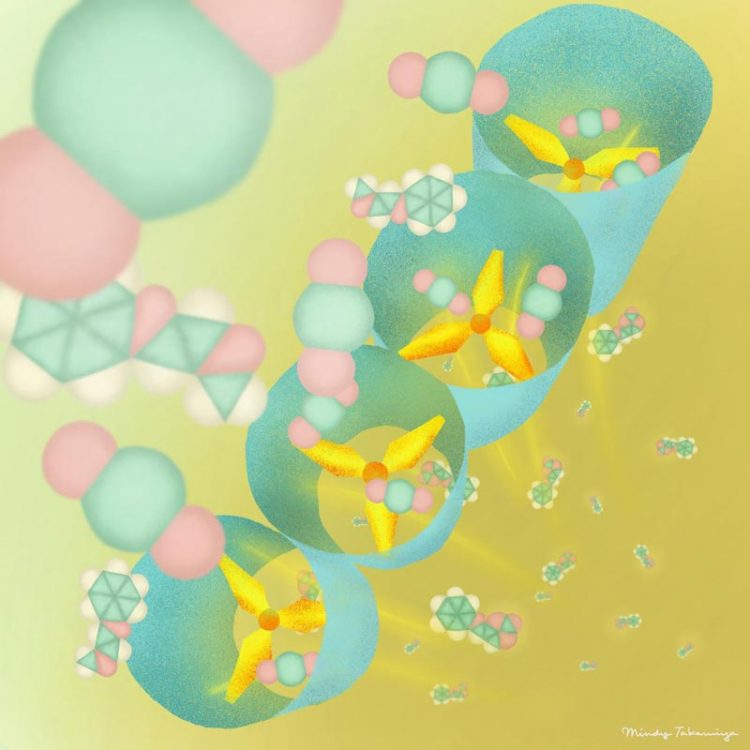New material captures carbon dioxide

This new porous coordination polymer has propeller-shaped molecular structures that enables selectively capturing CO2, and efficiently convert the CO2 into useful carbon materials. Illustration by Mindy Takamiya Usage Restrictions: CC BY 4.0 - Credit display required
A new material that can selectively capture carbon dioxide (CO2) molecules and efficiently convert them into useful organic materials has been developed by researchers at Kyoto University, along with colleagues at the University of Tokyo and Jiangsu Normal University in China. They describe the material in the journal Nature Communications.
Human consumption of fossil fuels has resulted in rising global CO2 emissions, leading to serious problems associated with global warming and climate change. One possible way to counteract this is to capture and sequester carbon from the atmosphere, but current methods are highly energy intensive. The low reactivity of CO2 makes it difficult to capture and convert it efficiently.
“We have successfully designed a porous material which has a high affinity towards CO2 molecules and can quickly and effectively convert it into useful organic materials,” says Ken-ichi Otake, Kyoto University materials chemist from the Institute for Integrated Cell-Material Sciences (iCeMS).
The material is a porous coordination polymer (PCP, also known as MOF; metal-organic framework), a framework consisting of zinc metal ions. The researchers tested their material using X-ray structural analysis and found that it can selectively capture only CO2 molecules with ten times more efficiency than other PCPs.
The material has an organic component with a propeller-like molecular structure, and as CO2 molecules approach the structure, they rotate and rearrange to permit C02 trapping, resulting in slight changes to the molecular channels within the PCP – this allows it to act as molecular sieve that can recognize molecules by size and shape. The PCP is also recyclable; the efficiency of the catalyst did not decrease even after 10 reaction cycles.
“One of the greenest approaches to carbon capture is to recycle the carbon dioxide into high-value chemicals, such as cyclic carbonates which can be used in petrochemicals and pharmaceuticals,” says Susumu Kitagawa, materials chemist at Kyoto University.
After capturing the carbon, the converted material can be used to make polyurethane, a material with a wide variety of applications including clothing, domestic appliances and packaging.
This work highlights the potential of porous coordination polymers for trapping carbon dioxide and converting into useful materials, opening up an avenue for future research into carbon capture materials.
###
DOI: 10.1038/s41467-019-12414-z
About Kyoto University's Institute for Integrated Cell-Material Sciences (iCeMS)
At iCeMS, our mission is to explore the secrets of life by creating compounds to control cells, and further down the road to create life-inspired materials that confront the myriad problems that afflict modern society. In only a decade, collaborative research at iCeMS has resulted in significant cutting-edge scientific discoveries, and the creation of over 1500 unique materials. We will keep running for the greater future of science.
https:/
For more information, contact
Mari Toyama/I. Mindy Takamiya
pe@mail2.adm.kyoto-u.ac.jp
Media Contact
More Information:
http://dx.doi.org/10.1038/s41467-019-12414-zAll latest news from the category: Materials Sciences
Materials management deals with the research, development, manufacturing and processing of raw and industrial materials. Key aspects here are biological and medical issues, which play an increasingly important role in this field.
innovations-report offers in-depth articles related to the development and application of materials and the structure and properties of new materials.
Newest articles

Trotting robots reveal emergence of animal gait transitions
A four-legged robot trained with machine learning by EPFL researchers has learned to avoid falls by spontaneously switching between walking, trotting, and pronking – a milestone for roboticists as well…

Innovation promises to prevent power pole-top fires
Engineers in Australia have found a new way to make power-pole insulators resistant to fire and electrical sparking, promising to prevent dangerous pole-top fires and reduce blackouts. Pole-top fires pose…

Possible alternative to antibiotics produced by bacteria
Antibacterial substance from staphylococci discovered with new mechanism of action against natural competitors. Many bacteria produce substances to gain an advantage over competitors in their highly competitive natural environment. Researchers…





















